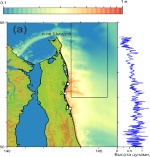Выпуск 6, 2016
Численное моделирование цунами и рельеф дна

Численное моделирование цунами и рельеф дна
Е. А. Куликов, В.К. Гусяков, А.А. Иванова, Б.В. Баранов
В работе рассматривается эффект влияния качества данных батиметрии на точность расчетов волнового поля цунами. Показано, что современные цифровые карты батиметрии, например, GEBCO, не обеспечивают адекватное воспроизведение рельефа дна в численных моделях распространения волн, что может приводить к существенным ошибкам при оценке максимальных заплесков цунами на побережье.
Показать АннотациюО влиянии разброса электронов пучка по скоростям на механизм черенковского пучково-плазменного взаимодействия
О влиянии разброса электронов пучка по скоростям на механизм черенковского пучково-плазменного взаимодействия
И.Н. Карташов, М.В. Кузелев
В линейном потенциальном приближении рассмотрена неустойчивость электронного пучка в холодной плазме для различных функций распределения электронов пучка по скоростям. Показано, что при увеличении разброса электронов пучка по скоростям происходит изменение механизма пучковой неустойчивости в плазме: гидродинамический одночастичный режим неустойчивости переходит в гидродинамический коллективный режим, или в одночастичный кинетический режим. Аналитически и численно определены инкременты неустойчивости в различных режимах.
Показать АннотациюЭффекты двумерных бифуркаций и квантовых биений в системе совмещенного атомного силового и сканирующего туннельного микроскопа с квантовыми точками
Эффекты двумерных бифуркаций и квантовых биений в системе совмещенного атомного силового и сканирующего туннельного микроскопа с квантовыми точками
В.Ч. Жуковский$^1$, В.Д. Кревчик$^2$, М.Б. Семенов$^2$, П.В. Кревчик$^2$, Р.В. Зайцев$^2$, И.А. Егоров$^2$
В рамках одноинстантонного приближения теоретически исследована полевая и температурная зависимости вероятности 2D – диссипативного туннелирования для модельного двухъямного осцилляторного потенциала в условиях внешнего электрического поля при конечной температуре с учетом влияния двух локальных фононных мод для квантовых точек в системе совмещенного атомного силового / сканирующего туннельного микроскопа. Показано, что в режиме синхронного параллельного переноса туннелирующих частиц с иглы кантилевера в квантовую точку наличие двух локальных фононных мод приводит к появлению двух устойчивых пиков на полевой зависимости вероятности 2D – диссипативного туннелирования. Проведено качественное сравнение теоретической кривой в пределе слабой диссипации с экспериментальной туннельной ВАХ для растущих квантовых точек из коллоидного золота под иглой кантилевера на начальном этапе формирования, когда размер квантовых точек не превышает 10 нм. Установлено, что на температурной зависимости вероятности 2D- диссипативного туннелирования один из двух устойчивых пиков, соответствующих взаимодействию туннелирующих частиц с двумя локальными фононными модами, может расщепляться на два, что связано с механизмом интерференции каналов туннелирования. Найдено, что вблизи точки бифуркации реализуется теоретически предсказанный и экспериментально наблюдаемый режим квантовых биений.
Показать АннотациюМедленные вариации электропроводности дистиллированной воды
Медленные вариации электропроводности дистиллированной воды
И.М. Агеев, Ю.М. Рыбин, Г.Г. Шишкин
Проведены экспериментальные исследования по измерению удельной электропроводности дистиллированной воды в условиях медленно меняющейся её температуры. Обнаружены периодические вариации электропроводности воды, наблюдаемые при скорости изменения температуры $dT/dt<0.1$ К/час. Периоды составляют более суток, амплитуды вариаций находятся в пределах от + 2,7% до – 2,3%. Обсуждаются возможные причины наблюдаемого явления.
Показать АннотациюАвтоволновая самоорганизация в неоднородных природно-антропогенных экосистемах
Автоволновая самоорганизация в неоднородных природно-антропогенных экосистемах
А.Э. Сидорова, Н.Т. Левашова, А.А. Мельникова, Н.Н. Дерюгина, А.Е.Семина
Рассмотрена пространственно-временная модель природно-антропогенных экосистем, как сопряженных активных сред, учитывающая неоднородности антропогенных и природных факторов. Подход направлен на выявление пороговых значений управляющих параметров. Теоретической базой системного анализа устойчивости экосистем служат синергетические представления об автоволновой самоорганизации в активных средах. Математическая модель базируется на модифицированной системе уравнений Фитц-Хью-Нагумо.
Показать Аннотацию
